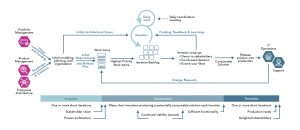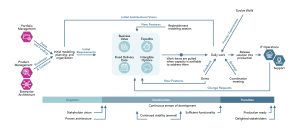Conducting technology, or more specifically, MarTech implementation projects, can be a complex endeavor. Given the scale, amount of cross-team coordination, and nuance involved in a successful implementation, it is important to have a project management system in place. In order to do this effectively, a team must thoughtfully employ the use of a project management methodology. When deciding what project management methodology to use for a MarTech implementation project, most teams choose Agile Scrum. The notion of “Agile” has proliferated in the IT world in recent years, so much so that the term has earned a square on many technology professionals’ buzzword bingo cards. While different project management methodologies, such as Agile Scrum, all have merits, there may be a better choice when conducting a MarTech implementation project.
In this blog, we will discuss Agile Scrum and its place as a staple project management methodology, along with one of its lesser-known alternatives: Lean. After discussing the differences in approach between the two, we will review some practical ways to implement Lean within your project team in order to achieve improved team effectiveness and efficiency.
What is a MarTech Project?
Before diving into the variances between Agile Scrum and Lean, we should first review what a MarTech implementation project is. Put simply, Marketing Technology, or MarTech, describes a range of software tools that assist a firm in achieving their marketing goals or objectives. A firm’s MarTech stack, or collection of MarTech tools working together, can include a wide gamut of individual tools such as a Customer Data Platform, Customer Relationship Management platform, ad campaign orchestration platforms, and more.
In order to integrate a new MarTech tool into one’s MarTech stack, a project team is needed to conduct the technology implementation. The implementations can be complex, requiring collaboration across various teams along with careful planning. Given the complexity and cost of these implementations, it is wise to thoughtfully consider the project management methodology used to ensure the implementation is executed successfully.
Agile, And More Specifically Scrum, Is A Commonly Chosen Project Management Methodology
When many people think of Agile as a project management methodology, they are likely envisioning Scrum. Agile is an overarching development philosophy that is rooted in its incremental and iterative approach. During Agile’s conception, twelve principles were established. Two of the most relevant principles are that an Agile team’s highest priority is to satisfy the customer through early and continuous delivery of valuable software and that Agile welcomes changing requirements. This focus on early delivery of working and valuable software, along with the agility to embrace and adapt to changing requirements, is a stark departure from the traditional waterfall approach to software development and has helped Agile become a mainstay across the technology industry.
While Agile provides a core philosophy and principles to software development, it does not alone offer a structured framework for how to pragmatically leverage its principles within a technology project; this is where Scrum comes in. Scrum is perhaps the most common implementation framework of Agile that utilizes the core principles of Agile while packaging it in a manner that helps provide structure to teams using it, partly through breaking down the construction phase of the project into short iterations, or sprints.

The above image helps illustrate the overarching project flow using Scrum. The project is broken down into work items, which reside in the backlog. Work is completed within a sprint, which is typically on a two-week cadence. Within each sprint, work items are pulled into the iteration backlog, with the goal of completing all of these work items within the sprint. Each sprint contains certain ceremonies, such as a daily standup, a demo at the end of the sprint, a sprint retrospective to review what did/didn’t work well, a sprint planning session to plan the next sprint, and a backlog grooming session to keep the work item backlog complete and tidy.
While Agile Scrum allows teams to adapt to changing requirements and deliver quick value, the rigidity of the sprint cadence, along with the administrative overhead of the prescribed ceremonies, can hinder a team’s effectiveness in many instances. As a result, project teams may never fully commit to Agile Scrum, and therefore may not benefit from the advantages that the framework offers compared to traditional waterfall. This is where Lean shines.
Lean Is a Strong Alternative to Agile Scrum, Focusing On Continuous Improvement And The Reduction Of Waste
Where Scrum is prescriptive with sprint time-boxes and rigid ceremonies, Lean takes a different approach to facilitating a technology project. Influenced by Lean manufacturing principles developed by Toyota in the early 20th century, Lean places an emphasis on continuous improvement, streamlined processes, and the elimination of all non-value-added activities. Examples of these non-value-added activities (or waste) include miscommunication, building the wrong thing, defects, and lost realization due to delays. Lean principles manifest by reducing bottlenecks, maintaining a continuous stream of work (and therefore maximizing flow), and minimizing work in progress.

The above image illustrates the overarching flow of a project using the Lean lifecycle. Lean features a continuous flow of development, rather than divvying up work into sprints. As a result, there is no iteration backlog. Instead, there is one main work item pool where all upcoming work items are stored until they can be addressed. Another differentiator with Lean is there is no prescribed cadence of ceremonies. Instead, ceremonies should only be held when they make sense and add value to the project. With this approach, retrospectives can be conducted at the end of a milestone or when needed, rather than at the end of each sprint. As for other ceremonies such as backlog grooming or stand-ups, these should be scheduled as one-offs, when and if appropriate.
Lean prioritizes the reduction of unnecessary work, encourages iterative and incremental development, and promotes collaboration across the project team. By acknowledging that different projects will have nuanced differences that call for different meeting cadences, Lean offers a much more pragmatic approach to managing a technology project.
The Project Management Methodology Used Can Have Substantial Impact on a MarTech Project’s Success
Choosing an ideal project management methodology and implementing it effectively can have a substantial impact on a MarTech implementation project’s success. With the complexity and scale of many MarTech implementation projects, employing a capable project management methodology is critical for success. Project managers should consider Lean as an alternative to Scrum, as it enables teams to deliver high-quality outcomes in a cost-effective and efficient manner. Given its flexibility and lessened administrative overhead when compared to Agile Scrum, Lean is an ideal choice for many MarTech implementation projects.
